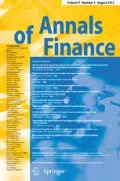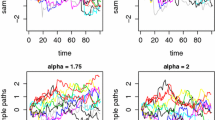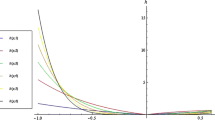Abstract
This paper presents a methodology of finding explicit boundaries for some financial quantities via comparison of stochastic processes. The path-wise comparison theorem is used to establish domination of the stock price process by a process with a known distribution that is relatively simple. We demonstrate how the comparison theorem can be applied in the constant elasticity of variance model to derive closed-form expressions for option price bounds, an approximate hedging strategy and a conditional value-at-risk estimate. We also provide numerical examples and compare precision of our method with the distribution-free approach.


Similar content being viewed by others
References
Barlow, M., Perkins, E.: One dimensional stochastic differential equations involving a singular increasing process. Stochastics 12, 229–249 (1984)
Bergenthum, J., Ruschendorf, L.: Comparison of semimartingales and Lèvy processes. Ann Probab 35(1), 228–254 (2007)
Black, F., Scholes, M.S.: The pricing of options and corporate liabilities. J Polit Econ 81(3), 637–654 (1973)
Carmona, R., Durrleman, V.: Generalizing the Black–Scholes formula to multivariate contingent claims. J Comput Finance 9(2), 43–67 (2006)
Cohen, S., Elliott, R., Pearce, C.: A general comparison theorem for backward stochastic differential equations. Adv Appl Probab 42(3), 878–898 (2010)
Cont, R., Tankov, P.: Financial Modeling with Jump Processes. Boca Raton: Chapman and Hall/CRC (2004)
Cox, J.C., Ross, S.A.: The valuation of options for alternative stochastic processes. J Financ Econ 3, 145–166 (1976)
Ding, X., Wu, R.: A new proof for comparison theorems for stochastic differential inequalities with respect to semimartingales. Stoch Process Appl 78(2), 155–171 (1998)
Galtchouk, L.I.: A comparison theorem for stochastic equations with integrals with respect to martingales and random measures. Teoriya Veroyatnostei i ee Primeneniya 27(3), 425–433 (1982). (English translation: Theory Probab Appl 27(3), 450–460, 1983)
Hajek, B.: Mean stochastic comparison of diffusions. Probab Theory Relat Fields 68, 315–329 (1985)
Jansen, K., Haezendonck, J., Goovaerts, M.J.: Upper bounds on stop-loss premiums in case of known moments up to the fourth order. Insur Math Econ 5, 315–334 (1986)
Jarrow, R., Rudd, A.: Approximate option valuation for arbitrary stochastic processes. J Financ Econ 10, 347–369 (1982)
Kloeden, P.E., Platen, E.: Numerical Solution of Stochastic Differential Equations. Applications of Mathematics. Berlin: Springer (1992)
Krasin, V.Y., Melnikov, A.V.: On comparison theorem and its applications to finance. In: Delbaen, F., et al. (eds.) Optimality and Risk: Modern Trends in Mathematical Finance, pp. 171–181. Berlin: Springer (2009)
Lèvy, H.: Upper and lower bounds of put and call option value: stochastic dominance approach. J Finance 40(4), 1197–1217 (1985)
MacBeth, J.D., Merville, L.J.: Tests of the Black–Scholes and Cox call option valuation models. J Finance 35(2), 211–219 (1980)
Melnikov, A.: On the theory of stochastic equations in components of semimartingales. Matematicheskii Sbornik 110(3), 414–427 (1979a). (English translation: Mathematics of the USSR. Sbornik 38(3), 381–394, 1981)
Melnikov, A.: Strong solutions of stochastic differential equations with non-smooth coefficients. Teoriya Veroyatnostei i ee Primeneniya 24(1), 146–149 (1979b). (English translation: Theory Probab Appl 24(1), 147–150, 1981)
Melnikov, A.: On solutions of stochastic equations with driving semimartingales. In: Proceedings of the Third European Young Statisticians Meeting, pp. 120–124. Leuven: Catholic University (1983)
Peng, S., Zhu, X.: Necessary and sufficient condition for comparison theorem of 1-dimensional stochastic differential equations. Stoch Process Appl 116(3), 370–380 (2006)
Platen, R., Heath, D.: A Benchmark Approach to Quantitative Finance. Berlin: Springer (2006)
Randal, J.: The Constant Elasticity of Variance Option Pricing Model. Master’s thesis, Victoria University of Wellington, Australia (1998)
Rockafellar, R.T., Uryasev, S.: Conditional value-at-risk for general loss distributions. J Bank Finance 26(7), 1443–1471 (2002)
Schepper, A.D., Heijnen, B.: Distribution-free option pricing. Insur Math Econ 40(2), 179–199 (2007)
Schroder, M.: Computing the constant elasticity of variance option pricing formula. J Finance 44(1), 211–219 (1989)
Skorokhod, A.V.: Studies in the Theory of Random Processes. Kyiv, USSR: Naukova Dumka (1961). (English translation: published by Addison-Wesley, Reading, MA, USA, 1965)
Yamada, T.: On comparison theorem for solutions of stochastic differential equations and its applications. J Math Kyoto Univ 13, 497–512 (1973)
Yan, J.-A.: A comparison theorem for semimartingales and its applications. Séminaire de probabilités Strasbourg 20, 349–351 (1986)
Acknowledgements
The authors thank the anonymous referee and the editor for their valuable comments and suggestions to improve the paper. Research supported by the NSERC under Grant 5901.
Author information
Authors and Affiliations
Corresponding author
Additional information
The research was supported by NSERC Grant #5901.
Appendix
Appendix
In order to prove Proposition 1, we shall use the fact that the conditional density of a CEV stock price may be expressed in terms of power series (see e.g. Randal 1998).
Denote by \(f_{\tau }(s)\) the conditional density of \(S_{t+\tau }\) given \( S_{t}\):
where
Note that
therefore
where \(g_{x}(n)\) is a probability mass function of a Poisson random variable with mean x.
If we choose such \(\alpha _{0},\alpha _{1},\dots \alpha _{m-1}\) that
and notice that
we can rewrite the expectation as
which concludes the proof. \(\square \)
Rights and permissions
About this article
Cite this article
Krasin, V., Smirnov, I. & Melnikov, A. Approximate option pricing and hedging in the CEV model via path-wise comparison of stochastic processes. Ann Finance 14, 195–209 (2018). https://doi.org/10.1007/s10436-017-0309-9
Received:
Accepted:
Published:
Issue Date:
DOI: https://doi.org/10.1007/s10436-017-0309-9
Keywords
- Stochastic differential equations
- Comparison theorem
- Option pricing
- Constant elasticity of variance model




